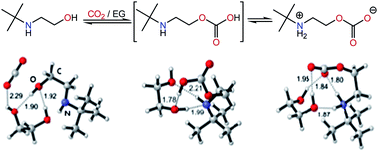Steric hindrance-induced zwitterionic carbonates from alkanolamines and CO2: highly efficient CO2 absorbents†
Abstract
Sterically hindered

* Corresponding authors
a
Department of Chemistry and Research Institute of Basic Sciences, Kyung Hee University, 1 Hoegi-dong, Dongdaemun-gu, Seoul, Korea
E-mail:
khs2004@khu.ac.kr, mcheong@khu.ac.kr
Fax: +82-2959-6443
Tel: +82-2961-0432/0239
b Department of Chemical Engineering, Kyung Hee University Yongin, Gyeonggi-do, Korea
Sterically hindered

 Please wait while we load your content...
Something went wrong. Try again?
Please wait while we load your content...
Something went wrong. Try again?
J. Im, S. Y. Hong, Y. Cheon, J. Lee, J. S. Lee, H. S. Kim, M. Cheong and H. Park, Energy Environ. Sci., 2011, 4, 4284 DOI: 10.1039/C1EE01801A
To request permission to reproduce material from this article, please go to the Copyright Clearance Center request page.
If you are an author contributing to an RSC publication, you do not need to request permission provided correct acknowledgement is given.
If you are the author of this article, you do not need to request permission to reproduce figures and diagrams provided correct acknowledgement is given. If you want to reproduce the whole article in a third-party publication (excluding your thesis/dissertation for which permission is not required) please go to the Copyright Clearance Center request page.
Read more about how to correctly acknowledge RSC content.
 Fetching data from CrossRef.
Fetching data from CrossRef.
This may take some time to load.
Loading related content
